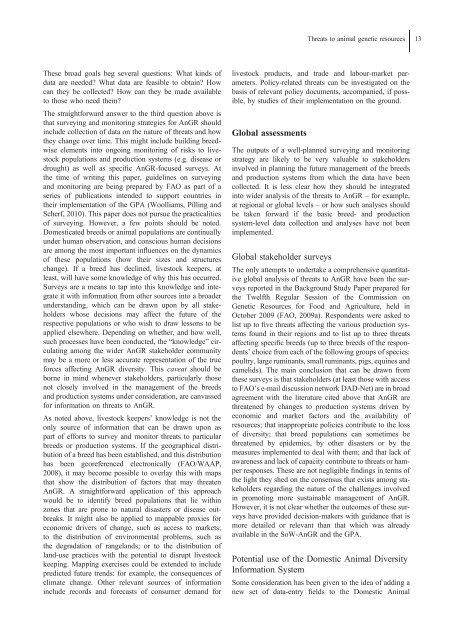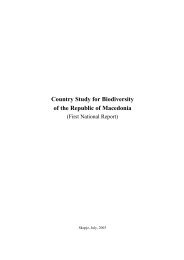Animal Genetic Resources - Convention on Biological Diversity
Animal Genetic Resources - Convention on Biological Diversity
Animal Genetic Resources - Convention on Biological Diversity
You also want an ePaper? Increase the reach of your titles
YUMPU automatically turns print PDFs into web optimized ePapers that Google loves.
Threats to animal genetic resources 13<br />
These broad goals beg several questi<strong>on</strong>s: What kinds of<br />
data are needed? What data are feasible to obtain? How<br />
can they be collected? How can they be made available<br />
to those who need them?<br />
The straightforward answer to the third questi<strong>on</strong> above is<br />
that surveying and m<strong>on</strong>itoring strategies for AnGR should<br />
include collecti<strong>on</strong> of data <strong>on</strong> the nature of threats and how<br />
they change over time. This might include building breedwise<br />
elements into <strong>on</strong>going m<strong>on</strong>itoring of risks to livestock<br />
populati<strong>on</strong>s and producti<strong>on</strong> systems (e.g. disease or<br />
drought) as well as specific AnGR-focused surveys. At<br />
the time of writing this paper, guidelines <strong>on</strong> surveying<br />
and m<strong>on</strong>itoring are being prepared by FAO as part of a<br />
series of publicati<strong>on</strong>s intended to support countries in<br />
their implementati<strong>on</strong> of the GPA (Woolliams, Pilling and<br />
Scherf, 2010). This paper does not pursue the practicalities<br />
of surveying. However, a few points should be noted.<br />
Domesticated breeds or animal populati<strong>on</strong>s are c<strong>on</strong>tinually<br />
under human observati<strong>on</strong>, and c<strong>on</strong>scious human decisi<strong>on</strong>s<br />
are am<strong>on</strong>g the most important influences <strong>on</strong> the dynamics<br />
of these populati<strong>on</strong>s (how their sizes and structures<br />
change). If a breed has declined, livestock keepers, at<br />
least, will have some knowledge of why this has occurred.<br />
Surveys are a means to tap into this knowledge and integrate<br />
it with informati<strong>on</strong> from other sources into a broader<br />
understanding, which can be drawn up<strong>on</strong> by all stakeholders<br />
whose decisi<strong>on</strong>s may affect the future of the<br />
respective populati<strong>on</strong>s or who wish to draw less<strong>on</strong>s to be<br />
applied elsewhere. Depending <strong>on</strong> whether, and how well,<br />
such processes have been c<strong>on</strong>ducted, the “knowledge” circulating<br />
am<strong>on</strong>g the wider AnGR stakeholder community<br />
may be a more or less accurate representati<strong>on</strong> of the true<br />
forces affecting AnGR diversity. This caveat should be<br />
borne in mind whenever stakeholders, particularly those<br />
not closely involved in the management of the breeds<br />
and producti<strong>on</strong> systems under c<strong>on</strong>siderati<strong>on</strong>, are canvassed<br />
for informati<strong>on</strong> <strong>on</strong> threats to AnGR.<br />
As noted above, livestock keepers’ knowledge is not the<br />
<strong>on</strong>ly source of informati<strong>on</strong> that can be drawn up<strong>on</strong> as<br />
part of efforts to survey and m<strong>on</strong>itor threats to particular<br />
breeds or producti<strong>on</strong> systems. If the geographical distributi<strong>on</strong><br />
of a breed has been established, and this distributi<strong>on</strong><br />
has been georeferenced electr<strong>on</strong>ically (FAO/WAAP,<br />
2008), it may become possible to overlay this with maps<br />
that show the distributi<strong>on</strong> of factors that may threaten<br />
AnGR. A straightforward applicati<strong>on</strong> of this approach<br />
would be to identify breed populati<strong>on</strong>s that lie within<br />
z<strong>on</strong>es that are pr<strong>on</strong>e to natural disasters or disease outbreaks.<br />
It might also be applied to mappable proxies for<br />
ec<strong>on</strong>omic drivers of change, such as access to markets;<br />
to the distributi<strong>on</strong> of envir<strong>on</strong>mental problems, such as<br />
the degradati<strong>on</strong> of rangelands; or to the distributi<strong>on</strong> of<br />
land-use practices with the potential to disrupt livestock<br />
keeping. Mapping exercises could be extended to include<br />
predicted future trends: for example, the c<strong>on</strong>sequences of<br />
climate change. Other relevant sources of informati<strong>on</strong><br />
include records and forecasts of c<strong>on</strong>sumer demand for<br />
livestock products, and trade and labour-market parameters.<br />
Policy-related threats can be investigated <strong>on</strong> the<br />
basis of relevant policy documents, accompanied, if possible,<br />
by studies of their implementati<strong>on</strong> <strong>on</strong> the ground.<br />
Global assessments<br />
The outputs of a well-planned surveying and m<strong>on</strong>itoring<br />
strategy are likely to be very valuable to stakeholders<br />
involved in planning the future management of the breeds<br />
and producti<strong>on</strong> systems from which the data have been<br />
collected. It is less clear how they should be integrated<br />
into wider analysis of the threats to AnGR – for example,<br />
at regi<strong>on</strong>al or global levels – or how such analyses should<br />
be taken forward if the basic breed- and producti<strong>on</strong><br />
system-level data collecti<strong>on</strong> and analyses have not been<br />
implemented.<br />
Global stakeholder surveys<br />
The <strong>on</strong>ly attempts to undertake a comprehensive quantitative<br />
global analysis of threats to AnGR have been the surveys<br />
reported in the Background Study Paper prepared for<br />
the Twelfth Regular Sessi<strong>on</strong> of the Commissi<strong>on</strong> <strong>on</strong><br />
<str<strong>on</strong>g>Genetic</str<strong>on</strong>g> <str<strong>on</strong>g>Resources</str<strong>on</strong>g> for Food and Agriculture, held in<br />
October 2009 (FAO, 2009a). Resp<strong>on</strong>dents were asked to<br />
list up to five threats affecting the various producti<strong>on</strong> systems<br />
found in their regi<strong>on</strong>s and to list up to three threats<br />
affecting specific breeds (up to three breeds of the resp<strong>on</strong>dents’<br />
choice from each of the following groups of species:<br />
poultry, large ruminants, small ruminants, pigs, equines and<br />
camelids). The main c<strong>on</strong>clusi<strong>on</strong> that can be drawn from<br />
these surveys is that stakeholders (at least those with access<br />
to FAO’s e-mail discussi<strong>on</strong> network DAD-Net) are in broad<br />
agreement with the literature cited above that AnGR are<br />
threatened by changes to producti<strong>on</strong> systems driven by<br />
ec<strong>on</strong>omic and market factors and the availability of<br />
resources; that inappropriate policies c<strong>on</strong>tribute to the loss<br />
of diversity; that breed populati<strong>on</strong>s can sometimes be<br />
threatened by epidemics, by other disasters or by the<br />
measures implemented to deal with them; and that lack of<br />
awareness and lack of capacity c<strong>on</strong>tribute to threats or hamper<br />
resp<strong>on</strong>ses. These are not negligible findings in terms of<br />
the light they shed <strong>on</strong> the c<strong>on</strong>sensus that exists am<strong>on</strong>g stakeholders<br />
regarding the nature of the challenges involved<br />
in promoting more sustainable management of AnGR.<br />
However, it is not clear whether the outcomes of these surveys<br />
have provided decisi<strong>on</strong>-makers with guidance that is<br />
more detailed or relevant than that which was already<br />
available in the SoW-AnGR and the GPA.<br />
Potential use of the Domestic <str<strong>on</strong>g>Animal</str<strong>on</strong>g> <strong>Diversity</strong><br />
Informati<strong>on</strong> System<br />
Some c<strong>on</strong>siderati<strong>on</strong> has been given to the idea of adding a<br />
new set of data-entry fields to the Domestic <str<strong>on</strong>g>Animal</str<strong>on</strong>g>
















